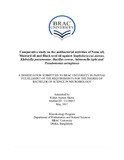| dc.contributor.advisor | Hossain, Dr. M. Mahboob | |
| dc.contributor.author | Azam, Sakia Binte | |
| dc.date.accessioned | 2017-11-13T05:05:41Z | |
| dc.date.available | 2017-11-13T05:05:41Z | |
| dc.date.copyright | 2017 | |
| dc.date.issued | 2017-05 | |
| dc.identifier.other | ID 13126009 | |
| dc.identifier.uri | http://hdl.handle.net/10361/8505 | |
| dc.description | This thesis report is submitted in partial fulfillment of the requirement for the degree of B.Sc in Microbiology, 2017. | |
| dc.description | Cataloged from PDF version of thesis report. | |
| dc.description | Includes bibliographical references. | |
| dc.description.abstract | The present study was carried out to determine the effectiveness of commercially available and common antiseptics that are used extensively in Bangladesh and other countries as well. Dettol, hexisol, oralon and betadine those antiseptics and disinfectants are extensively used in hospitals or home and health care settings for so many purposes. Mainly the antiseptics and disinfect are used to kill the microorganisms of the surface of living tissues. The effort was given to study the effectiveness of these four antiseptics against four well-known bacteria Staphylococcus aureus, Bacillus cereus, Pseudomonas aeruginosa, Klebsiella pneumoniae and for the effectiveness testing purposes the MIC, MBC and the disk diffusion method was performed. Both of the two tests showed that dettol, hexisol, oralon and betadine had the best antibacterial activity or effectiveness against Staphylococcus aureus compared to Klebsiella pneumonia, Pseudomonas aeruginosa and Bacillus cereus. Dettol was found to be the most effective disinfectant against Staphylococcus aureus compared to the two other antiseptics (considering the result of disk diffusion) but considering the dilution method it was found that comparatively dettol and betadine both were the most effective. Dettol was found to be more effective against Bacillus cereus but hexisol had the almost similar type of effectiveness as like dettol and both the oralon , betadine had more or less same type effectiveness and their effectiveness was less than hexisol and dettol for Bacillus cereus. It was found that dettol was very effective against Pseudomonas aeruginosa compared to hexisol, oralon and betadine. Also, dettol was very effective against Klebsiella pneumoniae but good effectiveness was also found for hexisol although betadine and oralon were less effective in that case. Overall through this study it was found that the four antiseptics (dettol, hexisol, oralon and betadine) had almost very good effectiveness (99.99%) against Staphylococcus aureus, Bacillus cereus, Pseudomonas aeruginosa, Klebsiella pneumonia. | |
| dc.description.statementofresponsibility | Sakia Binte Azam | |
| dc.language.iso | en | en_US |
| dc.publisher | BRAC Univeristy | en_US |
| dc.rights | BRAC University thesis are protected by copyright. They may be viewed from this source for any purpose, but reproduction or distribution in any format is prohibited without written permission. | |
| dc.subject | Antibacterial activity | |
| dc.title | Comparative study on the antibacterial activities of four commercially available antiseptics- Dettol, Hexisol, Oralon and Betadine against staphylococcus aureus, klebsiella pneumoniae , bacillus cereus, and pseudomonas aeruginosa | en_US |
| dc.type | Thesis | en_US |
| dc.contributor.department | Department of Mathematics and Natural Sciences, BRAC University | |
| dc.description.degree | B. Microbiology | |

